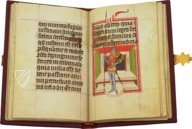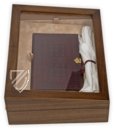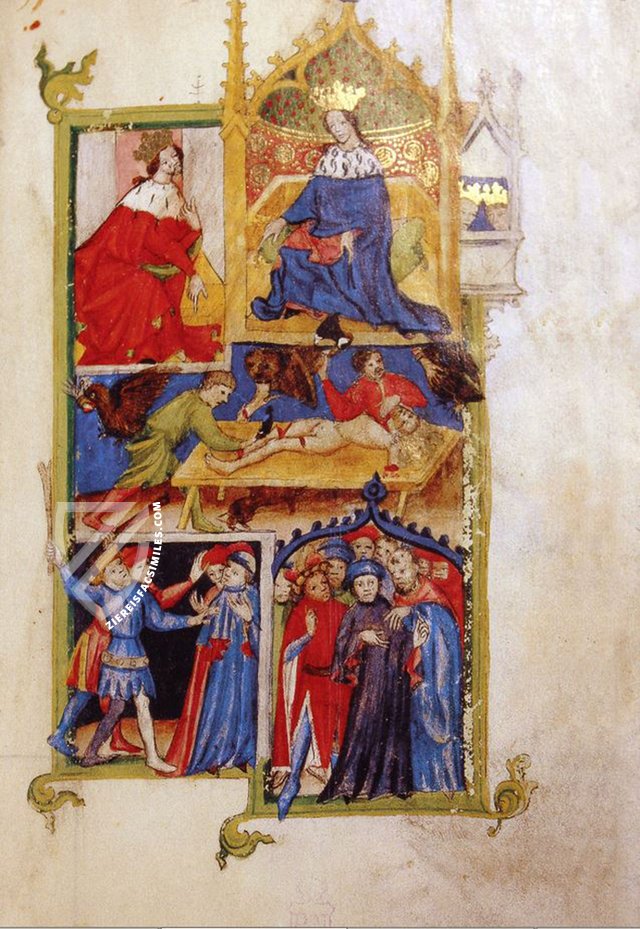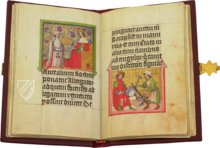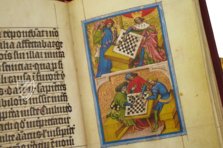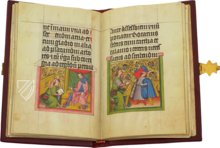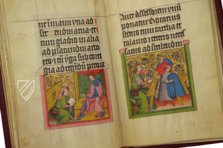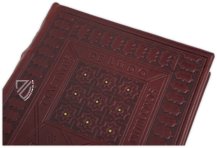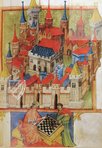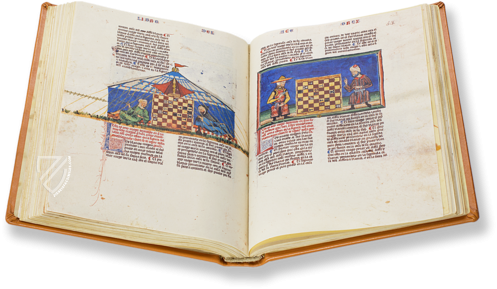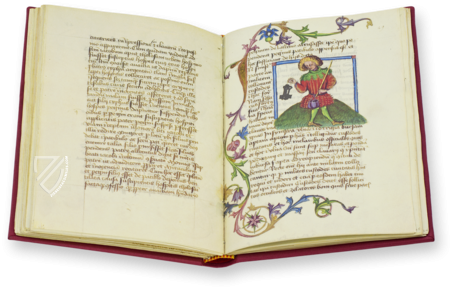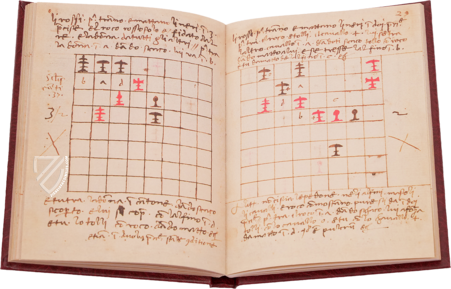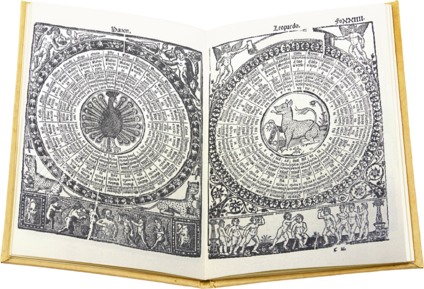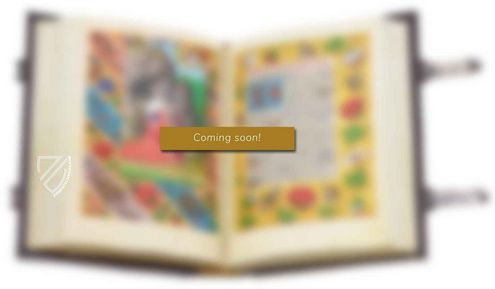Tractatus de Ludo Scacorum
(1,000€ - 3,000€)
The spell of chess has enchanted people since it came to Europe from Persia and Arabia in the Middle Ages. Treatises on chess enjoyed wide circulation from the 13th century onward. One of the first of these treatises that was concerned with the “royal game” was the chess book by Jacobus de Cessolis from the year 1330. The representation of the game of chess as an allegory of medieval society was widely distributed, sometimes in wonderfully designed manuscripts. The Spanish National Library in Madrid houses a truly splendid specimen that originated from Czechia at the beginning of the 15th century and enchants with its marvelous miniatures.
Tractatus de Ludo Scacorum
The spell of chess has enchanted people since it came to Europe from Persia and Arabia in the Middle Ages. Treatises on chess enjoyed wide circulation from the 13th century onward. One of the first of these treatises that was concerned with the “royal game” was the chess book by Jacobus de Cessolis from the year 1330. The representation of the game of chess as an allegory of medieval society was widely distributed, sometimes in wonderfully designed manuscripts. The Spanish National Library in Madrid houses a truly splendid specimen that originated from Czechia at the beginning of the 15th century and enchants with its marvelous miniatures.
The Famous Author of the Chess Treatise
Jacobus de Cessolis was an Italian Dominican monk from the 14th century. Cessolis published his chess treatise in 1330 under the title Liber de moribus hominum et officiis nobilium ac popularium super ludo scacchorum (Book of the Customs of Man and the Duties of the Nobles and Commoners via the Game of Chess). With this document – one of the first that concerned itself with the strategy game in detail – Cessolis obtained great fame and was known across Europe. His chess book was one of the most widely read books of the Late Middle Ages.
King, Lady, Peasant…
In his chess book, Jacobus de Cessolis assembled texts from sermons, in which the game of kings served as an allegory for society. The various ranks of medieval society were conveyed in an exciting manner: there is a king and a peasant, but various other professions play a role as well. In this way, de Cessolis wanted to emerge morally-didactically as an arbiter of value, employing the symbolism of chess for this. This societally critical aspect is probably the what lent his entertaining chess book such great popularity**. After the Bible, it was probably the most widely read literary work of this time period!**
The Grandiose Artistic Furnishings
Jacobus de Cessolis’ chess book also offered wonderful examples for illumination. Numerous fascinating manuscripts attest to that. An exceptional specimen of these illustrated chess books was made in Prague ca. 1400–1425. The codex, which resides today in Madrid, collects impressive miniatures across 100 pages, which richly illustrate the Latin text. 15 mostly half-page miniatures present benign scenes of the game of chess before an elaborately designed gold background from both everyday life or with royal protagonists. For example, the spell of chess is clarified in a depiction of wildly gesticulating players, who have assembled around a board. That the artist who created these miniatures was a master of his trade is evidenced by the exceptional quality of the paintings. An amazing spatiality characterizes the miniatures, whether they be interior scenes or the depiction of a city. The figures were tenderly characterized and appointed with a variety of colors. Thus the artist was able to lend the simultaneously entertaining and educational chess treatise of Jacobus de Cessolis an appropriately artistic framework.
Codicology
- Alternative Titles
- The Play of Chess by Jacobus de Cessolis
Schachbuch des Jacobus de Cessolis
Liber de moribus hominum et officiis nobilium sive super ludum scaccorum - Size / Format
- 100 pages / 17.5 × 11.5 cm
- Origin
- Czech Republic
- Date
- 1400–1425
- Epochs
- Style
- Genre
- Language
- Script
- Gothic minuscule
- Illustrations
- 15 miniatures
- Artist / School
- Jacobus de Cessolis (author)
- Previous Owners
- Cardinal Francisco Javier Zelada
Innocenzo Romano
Toledo’s Cathedral
Tractatus de Ludo Scacorum
Playing Chess with a King
Three chess players are shown seated before tapestries illuminated with gold in what is presumably a parlor. Dressed in ermine-trimmed robes and wearing a golden crown, a king is shown playing chess against a nobleman dressed in blue. Another gentleman dressed in green with a floppy pink hat leans in and puts his arm on his shoulder. Is he advising the player on what move to make next, or is he counselling his friend that the safest strategy is to just let the king win?
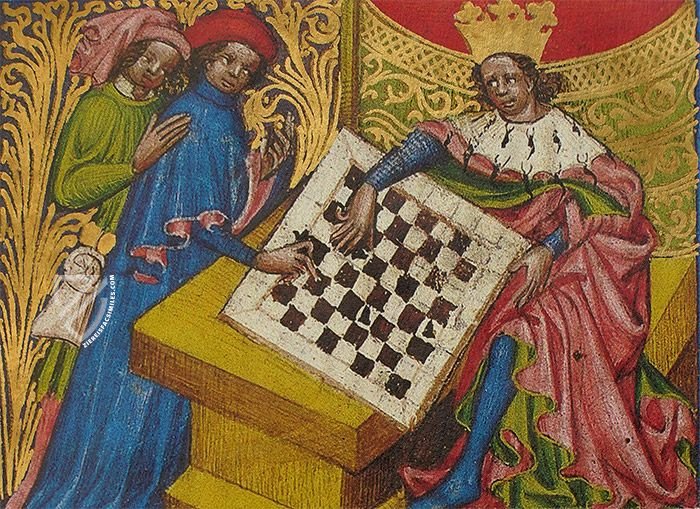
Tractatus de Ludo Scacorum
The City of Babylon
Chess was often presented as a metaphor for the idealized city of Babylon, which was itself a metaphor for an orderly world during the Middle Ages. The chess board’s 64 squares both represent the length of Babylon’s city walls – 64 miles according to legend – and the neat grid pattern into which the city was divided. Ancient Babylon is presented here in the style of a late medieval city.
Two richly dressed men sit opposite one another playing chess in the bas-de-page miniature, the stylized folds of their clothing exhibiting the influence of the so-called Zackenstil. Elevated by a splendid green background with gold leaf filigree tendrils, an early attempt at perspective allows for many details of the city to be seen both inside and out.

#1 Tractatus de Ludo Scacorum
Language: Spanish
(1,000€ - 3,000€)
#2 Trattato sul Gioco degli Scacchi
(3,000€ - 7,000€)
- Treatises / Secular Books
- Apocalypses / Beatus
- Astronomy / Astrology
- Bestiaries
- Bibles / Gospels
- Chronicles / History / Law
- Geography / Maps
- Saints' Lives
- Islam / Oriental
- Judaism / Hebrew
- Single Leaf Collections
- Leonardo da Vinci
- Literature / Poetry
- Liturgical Manuscripts
- Medicine / Botany / Alchemy
- Music
- Mythology / Prophecies
- Psalters
- Other Religious Books
- Games / Hunting
- Private Devotion Books
- Other Genres
- Afghanistan
- Armenia
- Austria
- Belgium
- Colombia
- Croatia
- Czech Republic
- Denmark
- Egypt
- Ethiopia
- France
- Germany
- Hungary
- India
- Iran
- Iraq
- Israel
- Italy
- Japan
- Luxembourg
- Mexico
- Morocco
- Netherlands
- Peru
- Poland
- Portugal
- Russia
- Serbia
- Spain
- Sri Lanka
- Sweden
- Switzerland
- Syria
- Turkey
- Ukraine
- United Kingdom
- United States
- Uzbekistan
- Aboca Museum
- Ajuntament de Valencia
- Akademie Verlag
- Akademische Druck- u. Verlagsanstalt (ADEVA)
- Aldo Ausilio Editore - Bottega d’Erasmo
- Alecto Historical Editions
- Alkuin Verlag
- Almqvist & Wiksell
- Amilcare Pizzi
- Andreas & Andreas Verlagsbuchhandlung
- Archa 90
- Archiv Verlag
- Archivi Edizioni
- Arnold Verlag
- ARS
- Ars Magna
- ArtCodex
- AyN Ediciones
- Azimuth Editions
- Badenia Verlag
- Bärenreiter-Verlag
- Belser Verlag
- Belser Verlag / WK Wertkontor
- Benziger Verlag
- Bernardinum Wydawnictwo
- BiblioGemma
- Biblioteca Apostolica Vaticana (Vaticanstadt, Vaticanstadt)
- Bibliotheca Palatina Faksimile Verlag
- Bibliotheca Rara
- Boydell & Brewer
- Bramante Edizioni
- Brepols Publishers
- British Library
- C. Weckesser
- Caixa Catalunya
- Canesi
- CAPSA, Ars Scriptoria
- Caratzas Brothers, Publishers
- Carus Verlag
- Circulo Cientifico
- Club Bibliófilo Versol
- Club du Livre
- CM Editores
- Collegium Graphicum
- Collezione Apocrifa Da Vinci
- Comissão Nacional para as Comemorações dos Descobrimentos Portugueses
- Coron Verlag
- Corvina
- CTHS
- D. S. Brewer
- De Agostini/UTET
- De Schutter
- Deuschle & Stemmle
- Deutscher Verlag für Kunstwissenschaft
- DIAMM
- Droz
- E. Schreiber Graphische Kunstanstalten
- Ediciones Boreal
- Ediciones Grial
- Ediclube
- Edições Inapa
- Edilan
- Editalia
- Edition Georg Popp
- Edition Leipzig
- Edition Libri Illustri
- Editiones Reales Sitios S. L.
- Éditions de l'Oiseau Lyre
- Editions Medicina Rara
- Editorial Casariego
- Editorial Mintzoa
- Editrice Antenore
- Editrice Velar
- Edizioni Edison
- Egeria, S.L.
- Eikon Editores
- Electa
- Enciclopèdia Catalana
- Eos-Verlag
- Ephesus Publishing
- Eugrammia Press
- Extraordinary Editions
- Fackelverlag
- Facsimila Art & Edition
- Facsimile Editions Ltd.
- Facsimilia Art & Edition Ebert KG
- Faksimile Verlag
- Feuermann Verlag
- Folger Shakespeare Library
- Franco Cosimo Panini Editore
- Friedrich Wittig Verlag
- Fundación Hullera Vasco-Leonesa
- G. Braziller
- Gabriele Mazzotta Editore
- Gebr. Mann Verlag
- Gesellschaft für graphische Industrie
- Getty Research Institute
- Giovanni Domenico de Rossi
- Giunti Editore
- Graffiti
- Grafica European Center of Fine Arts
- Guido Pressler
- Guillermo Blazquez
- H. N. Abrams
- Harrassowitz
- Helikon
- Hendrickson Publishers
- Henning Oppermann
- Herder Verlag
- Hes & De Graaf Publishers
- Hoepli
- Hortus Deliciarum
- Houghton Library
- Hugo Schmidt Verlag
- Idion Verlag
- Il Bulino, edizioni d'arte
- ILte
- Imago
- Insel Verlag
- Instituto de Estudios Altoaragoneses
- Instituto Nacional de Antropología e Historia
- Istituto dell'Enciclopedia Italiana - Treccani
- Istituto Ellenico di Studi Bizantini e Postbizantini
- Istituto Geografico De Agostini
- Istituto Poligrafico e Zecca dello Stato
- Italarte Art Establishments
- J. Thorbecke
- Jan Thorbecke Verlag
- Johnson Reprint Corporation
- Jugoslavija
- Karl W. Hiersemann
- Kasper Straube
- Kaydeda Ediciones
- Konrad Kölbl Verlag
- Kurt Wolff Verlag
- La Liberia dello Stato
- La Linea Editrice
- La Meta Editore
- Lambert Schneider
- Landeskreditbank Baden-Württemberg
- Leo S. Olschki
- Les Incunables
- Library of Congress
- Libreria Musicale Italiana
- Lichtdruck
- Lito Immagine Editore
- Lumen Artis
- Lund Humphries
- M. Moleiro Editor
- Maison des Sciences de l'homme et de la société de Poitiers
- Manuscriptum
- Maruzen-Yushodo Co. Ltd.
- MASA
- McGraw-Hill
- Militos
- Millennium Liber
- Müller & Schindler
- National Library of Wales
- Neri Pozza
- Nova Charta
- Oceanum Verlag
- Odeon
- Orbis Mediaevalis
- Orbis Pictus
- Österreichische Staatsdruckerei
- Oxford University Press
- Pageant Books
- Parzellers Buchverlag
- Patrimonio Ediciones
- Pattloch Verlag
- PIAF
- Pieper Verlag
- Plon-Nourrit et cie
- Prestel Verlag
- Princeton University Press
- Prisma Verlag
- Priuli & Verlucca, editori
- Pro Sport Verlag
- Propyläen Verlag
- Pytheas Books
- Quaternio Verlag Luzern
- Reales Sitios
- Recht-Verlag
- Reichert Verlag
- Reichsdruckerei
- Riehn & Reusch
- Roberto Vattori Editore
- Rosenkilde and Bagger
- Roxburghe Club
- Salerno Editrice
- Sarajevo Svjetlost
- Schöck ArtPrint Kft.
- Scolar Press
- Scrinium
- Scripta Maneant
- Scriptorium
- Siloé, arte y bibliofilia
- SISMEL - Edizioni del Galluzzo
- Sociedad Mexicana de Antropología
- Sorli Ediciones
- Stainer and Bell
- Styria Verlag
- Sumptibus Pragopress
- Szegedi Tudomànyegyetem
- Taberna Libraria
- Tarshish Books
- Taschen
- Tempus Libri
- Testimonio Compañía Editorial
- Thames and Hudson
- The Clear Vue Publishing Partnership Limited
- The Facsimile Codex
- The Folio Society
- The Marquess of Normanby
- The Richard III and Yorkist History Trust
- Tip.Le.Co
- TouchArt
- TREC Publishing House
- TRI Publishing Co.
- Trident Editore
- Typis Regiae Officinae Polygraphicae
- Universidad de Granada
- University of California Press
- University of Chicago Press
- Urs Graf
- Vallecchi
- Van Wijnen
- VCH, Acta Humaniora
- VDI Verlag
- Verlag für Regionalgeschichte
- Verlag Styria
- Vicent Garcia Editores
- W. Turnowsky
- Wiener Mechitharisten-Congregation (Wien, Österreich)
- Wissenschaftliche Buchgesellschaft
- Xuntanza Editorial
- Zollikofer AG











